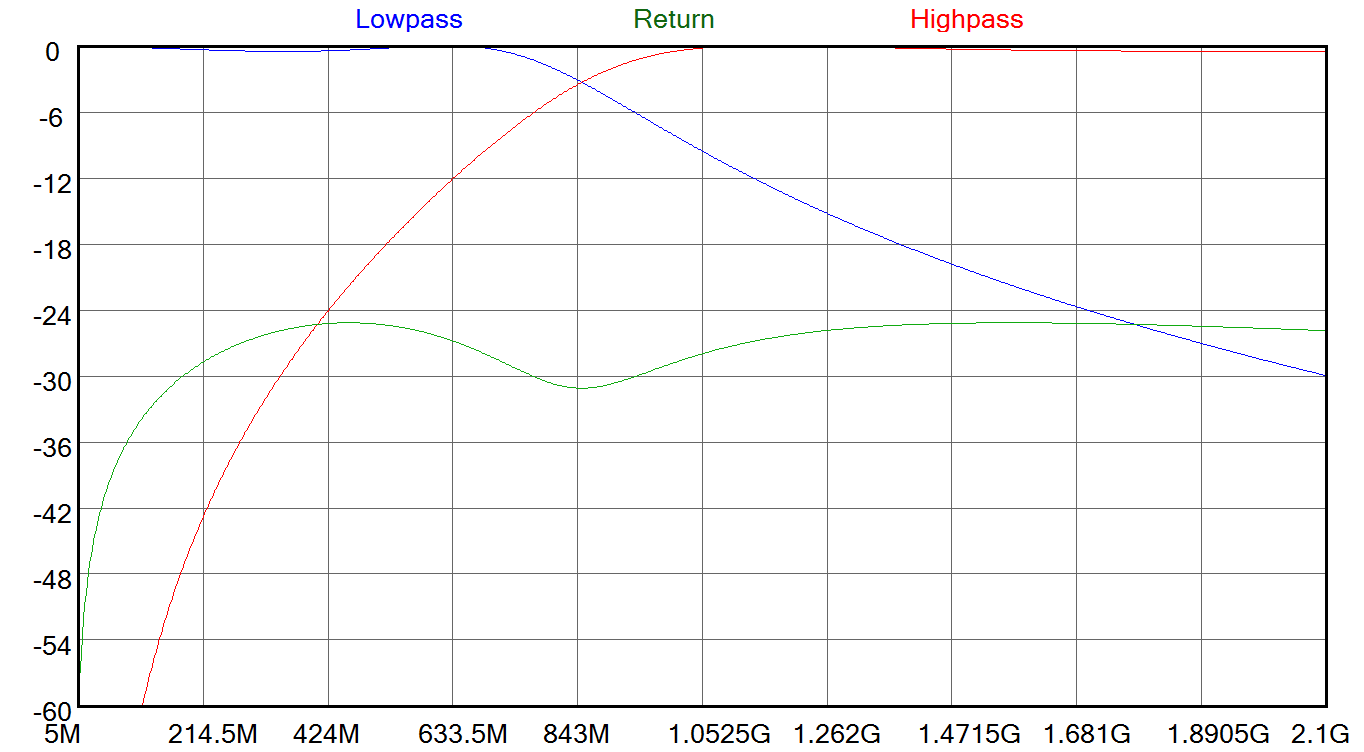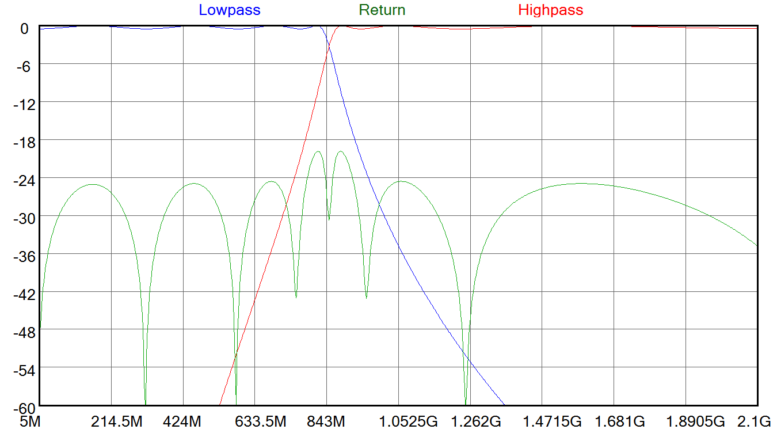If you read this thread, you know a little bit about diplexers. Have you ever wondered how a diplexer really works? A diplexer, as you know, is a device for taking the signal from two cables and putting it onto one. For example, you may want to put your antenna and satellite signal on one cable, to make it easier to distribute it in your home. It works because (in most cases) the signal used for satellite video is on different frequencies than the signal for over-the-air. You can’t just twist the wires together, though… it wouldn’t work. That’s what a cheap combiner does, and it hardly ever works well. So how does it work? A diplexer has filters [like the crossover in a stereo speaker] that are made up from a low pass and high pass filters, what makes a good one from a cheap one is how much filtering is done. You can see by these plots, that the more components [cost] used, the better rejection each filter has.
At top a good diplexer. It does a great job of isolating the two signals from the two sources, so that when the signals are added to the same wire, there is very little noise transferred to the final connection. Look at the red and blue lines and how steep they are. This is an indication that very few “unwanted” signals are going to be transferred.

This is a cheap diplexer. If you look at the red and blue lines, you can see that there are a lot of extra signals that get transferred. This diplexer would make for a noisy or weak signal if you used it, and that might mean poor quality audio and video. On the other hand, this same device might be ok if it were used as a splitter. In the case of a splitter, it’s not as important for the signals to be completely isolated. A tuner can “listen” to only the parts of the signal that are required.
Let’s look at a real-world scenario.
When you receive a satellite signal, The LNB not only has the signals you want, but also has noise throughout its bandwidth. The noise can be in the same frequency range as an antenna signal. If the diplexer doesn’t reject out of band signals well, this noise will also pass through, with maybe -10dB attenuation. This level of noise can be high enough to mask the low power of the OTA signals, so while you may have a good antenna, the noise from the dish bleeds through and swamps out the OTA.
Now on the other end, where you’re separating the two bands, this -10dB is enough that 90% of each signal goes where it should and the tuners aren’t outputting any signals that need rejection.
This is all well and good… until DECA comes into the picture. (DECA is DIRECTV’s implementation of the MoCA standard.) DECA is on the order of being 30 dB higher in power than anything else. Even with the best diplexer, a DECA signal could still bleed through and cause problems with a weak OTA signal.
Things are a little more complicated with the DIRECTV HR34, because it has a built-in MoCA adapter doesn’t seem to be disabled even when it’s unused. There are some definite indications that the HR34 shouldn’t be used for diplexing, although there’s no statement from DIRECTV yet. One option to fix this would be using a band stop filter to keep the signal from going out but it would just send the signal right back into the HR34 at full power. It’s hard to know what problems this would cause over time.
In this case, the NAS diplexer could be the best option. You could use one as a combiner at the SWiM, another as a separator near the HR34, and then connect a third as a combiner, but terminate the OTA port. This will have the DECA “split” to the load, and have twice the rejection of the NAS before it reaches the OTA signals.
The NAS is the only diplexer that is made to pass the SWiM 2.3 MHz control signal, which when you’re stacking three inline, will be important. All the other diplexers may nor may not work well for SWiM because this 2.3 MHz signal, to get to the SWiM, has to pass through the DC power circuit. Diplexers for cable need to pass signals down in the 10-20 MHz range to the OTA port for things like internet and digital cable communication, so the quality of the diplexer is important.
There are many different options for diplexing. Internet service from a cable company could be diplexed in with satellite service. There are a lot of possibilities where diplexing could save time and money. Choosing the right parts for the job, and doing a little research, can really pay off.





